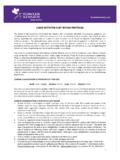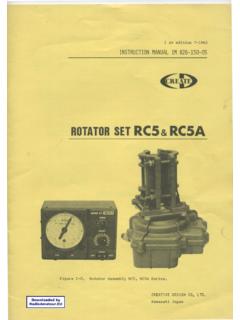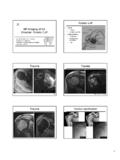Transcription of APATIENT GUIDE TO FAILED ROTATOR CUFF …
1 1 A PATIENT GUIDE TO FAILED ROTATOR cuff REPAIRS Edward G McFarland MD Maad Al Saati MD Juan Garzon Muvdi MD Sonal Sodha Gaelle Why am I still having symptoms after ROTATOR cuff surgery? The most common causes of pain after ROTATOR cuff surgery are (1) that the shoulder is still recovering from the surgery itself and (2) the shoulder has gotten stiff due to lack of movement. It is well known that ROTATOR cuff surgery is a major operation where the ROTATOR cuff tendons (Figure 1) are sewn back to the upper arm bone (humerus) (See a Patient GUIDE to ROTATOR cuff repair ) (Figures 2 and 3). The other major reason patients have pain after ROTATOR cuff surgery is due to stiffness of that shoulder (See a Patient GUIDE to Stiffness). It is common after ROTATOR cuff surgery to have some stiffness due to the fact that the operation caused the arm to be held without motion for some time.
2 It is important after the surgery to protect the ROTATOR cuff repair for several weeks while it heals, and during this time it is very common for the shoulder to get stiff to a lesser or greater degree. Your doctor and physical therapist can keep an eye on this for you and let you know if your stiffness is the expected amount or too excessive. Often times the stiffness can be treated, and the pain resolves. Figure 1: ROTATOR cuff tendons 2 It takes the repaired ROTATOR cuff tendons about 6 weeks to heal initially to the bone, 3 months to form a relatively strong attachment to the bone, and about 6 to 9 months before the tendon is completely healed to the bone. Most patients who have had ROTATOR cuff surgery will tell you that it takes about 9 months before the shoulder feels completely normal.
3 This observation is supported by a study showing that in patients who have had ROTATOR cuff surgery, strength in the shoulder muscles is not fully recovered until 9 months after the surgery [2 6]. As a result, it is normal to expect some continued symptoms of pain or soreness after ROTATOR cuff surgery for several months. How do I treat the stiffness? You should always follow the directions of your surgeon after surgery, since some tears need more time to heal than other tears. The best thing is to listen to your doctor as well as the physical therapist involved in your care. We tell our patients that ice is helpful for the pain, along with pain medicine of some sort, such as acetaminophen ( Tylenol), anti inflammatory medications ( aspirin, ibuprofen, naproxen etc), pain relievers (non narcotic or narcotic) and even prednisone by mouth ( cortisone dose packs).
4 You should take these medications only at the direction of your doctor. We usually recommend that during the first 3 months the emphasis in physical therapy and with your home program should be on regaining motion in your fingers, wrist, elbow and shoulder. We tell patients they have the rest of their lives to get strong, but during the first four months after ROTATOR cuff surgery, the major goal should be largely to regain motion in the shoulder. Stiffness in the shoulder can be the cause of pain months after the surgical repair , so it is important that stiffness be addressed even months or years after the surgery. Figure 2: Torn ROTATOR cuff tendon Figure 3: ROTATOR cuff tendon sewn back to the upper arm bone3 How much therapy should I have after surgery?
5 Your surgeon can answer this since they are the ones who know how much work had to be done to repair the tendons. The doctors can prescribe therapy based on the work done during the operation. If more than one tendon had to be repaired or if the tendon tear is a big tear, the surgeon may recommend that the therapy progress slower to allow more time for healing; on the other hand, if the tear is small, they may allow a little more motion earlier than usual after the surgery. It is possible to have too much therapy, and that is usually experienced as lots of pain after the therapy session or pain for days after the therapy session. It is important that the physical therapist has a dialogue with you to make sure that the exercises are done at a proper pace for your particular surgery.
6 We typically recommend physical therapy only twice a week. However, we recommend that patients stretch on their own on the other days when they do not see the therapist. Sometimes physical therapy with the therapist three times a week is indicated, and this should be discussed with your physician and physical therapist. Similarly, it is typically not necessary to stretch more than once or at most twice a day with a home program. Lastly, if strengthening exercises are causing you pain, we recommend that you do not do the exercises over 60 degrees of elevation of the shoulder (Figure 4). This is because the ROTATOR cuff begins to have increased stress above this level, and it can worsen the pain if the shoulder is irritated already. We recommend that you ice the shoulder after any exercise program to keep the pain under control.
7 What if I feel a tear or pull in therapy? It is not uncommon to have a small twinge or pull in physical therapy, which typically does not mean that the ROTATOR cuff repair has FAILED . Normally these small twinges are usually nothing to worry about. It is not really known what causes them, but it is believed that it may be scar tissue being stretched or the shoulder joint moving around normally in the socket. It would be rare for the therapy to actually cause a repaired tendon to tear, as will be discussed later in this GUIDE . Figure 4: If exercises are causing you pain, we recommend that you do not do exercises over 60 degrees of elevation of the shoulder. 4 How do I know if the tendon repair has torn again? It is not easy to tell if the ROTATOR cuff tendon repair has FAILED or not.
8 The symptoms of pain or loss of strength are common after ROTATOR cuff surgery while the tendons are healing, and minor setbacks are to be expected. We do not recommend a magnetic resonance scan or other studies when these setbacks occur for several reasons. The first reason is that magnetic resonance imaging after a surgical repair of the ROTATOR cuff does not have the same accuracy in determining whether tendons are torn. If an MRI is performed, we recommend that it be performed with dye in the affected shoulder (arthrogram) with a needle under X ray or CAT scan guidance by a radiologist. This test is called an arthrogram MRI and may be positive if the tendon has not had enough time to heal or if parts of the tendon have not healed to bone. As a result, within three months after a ROTATOR cuff repair , it is common for the dye to leak through the tendon since it has not completely healed.
9 After this period of time, the degree of tear in the tendons can be determined best with this study. What do I do if my tendon has not healed? The reality of ROTATOR cuff surgery is that while most tendons heal back to the bone after surgery, not all repaired tendons heal completely, and some do not heal at all. There are many reasons for this lack of healing with surgery. The first is that the ROTATOR cuff tendons are large tendons which may have too extensive damage to heal. The ROTATOR cuff tendons are big, and there are four of them. Each ROTATOR cuff tendon is as thick as your little finger and as wide as two to three fingers. The chance that the tendons will heal with surgery is directly related to how large the tear in the tendons was before surgery.
10 How to determine the size of the ROTATOR cuff tendon tear will be discussed below. The second reason that the tendons may not have healed with surgery is that that these tendons begin to wear out in most humans beginning around the age of 30, and the amount of wear and tear varies from person to person for reasons we do not understand. This wear of the tendons occurs in some people but not in others. By the age of 50, many people have some wear of their ROTATOR cuff tendons. When ROTATOR cuff tendons tear prior to any surgery, there are two ways they can tear. The first is that there is an injury that pulls the tendon off of the bone. When this happens, there is still some tendon left to repair with very little tendon missing. However, in many cases when the tendon tears with minimal trauma, the reason the tendon tore in the first place was because it already had some tearing due to wear and tear over the years.







